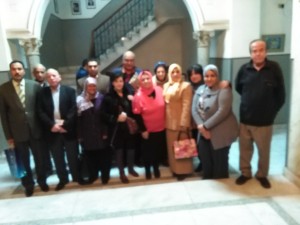Radwa Ashour's Siraaj promises a continuity of the revolution till “Bread, freedom, and social justice” are finally achieved says Mona el-Namoury.
From a presentation at Arab Spring Conference, Cairo University, 18-20 February 2012
It was during last November when I first read Siraaj by Radwa Ashour, while the sad events of Mohamed Mahmoud Street—the Eyes of Freedom Street—were going on. I needed an escape from all the news, from my own short, cough-filled trips to Tahrir delivering medical supplies to the field hospitals, from the vague future that infinitely stretched ahead and the daily hassle helping my kids study. I picked that thin blue book from my library that read Siraaj, an Arab Tale, promising myself a fantastic escape into a world of harems, sultans, banquets, and hopefully a little bit of good sex. A little voice inside me whispered. Are you kidding? Is this the escape you want? Reading for professor Radwa, the strict, idealist, powerful person? But it was too late to go back; I had been in the car by that time.
The sultan, the harems, banquets, even good Arab horses were there — sex was not, unfortunately — and also were the poor, the slaves, the frightened widowed women, the colonizer, the prisons, the thwarted uprisings, the pain, the tears, and — as Ashour describes the Palestinian children with stones in their hands in front of the Israeli tanks: They choose a minute of an absolute meaning and ability: intense freedom followed by death. They buy this minute with their entire lives. Is it madness? It is beautiful madness because that minute is more precious than an extended life in helplessness and humiliation. The situation is painfully repeated in all the streets of the Arab Spring movements, where the Arab youth face the military machine of the dictators.
Thus Ashour’s fictional trip to a 19th century Alexandria bombarded by the colonizing British ships, which is followed by a trip to an imaginary island ruled by a British-allied totalitarian sultan ends, for me as a reader, right here, right now. The island is an ‘every-Arab-island’ in the middle of every Arab uprising against their dictators.
The writing of Siraaj was influenced by nationality and gender. This is what Ashour says about her writing experience in “My Experience with Writing” in The View from Within:
I am an Arab woman and a citizen of the Third World and my heritage in both cases is stifled. I know this truth right down to the marrow of my bones, and I fear it to the extent that I write in self-defense and in defense of countless others with whom I identify or who are like me. I want to write because reality fills me with a sense of alienation. Silence only increases my alienation, while confession opens up so that I may head out towards the others or they may come to me themselves.
In the case of the Middle East, the alliances that the neo-colonial West has taken with the Middle Eastern dictatorships for the indirect sake of Israel, a shameful extension of colonialism, led to creating a strange case of simultaneous existing colonialism and postcolonialism in the region. This is how I see Ashour situating her novel as a play: going back historically, travelling in imagination, and arriving right here, right now. For, as she herself analyzes the genre and its relation with time in an interview with Ahmed Al-Shoraiky in Aljazeera.net: All novels are historical in a sense. The writer’s /reader’s engagement should also be with novels whose events take place in the past. This is an intended engagement presenting a world parallel to ours and calling the reader to find connections.
Talking about her first experience with Western other in her first book AlRihlah, Ashour says:
I set out full of doubt and fear, perhaps even bitterness toward the imperial other…then, I was a woman. The eye that sees and the perception that classifies and organizes the vocabulary of experience, both, impose their different constrains which are in turn-reflected in the purport of the experience and the writing of it.
It is indeed the eye of the woman that arranges the experience in Siraaj. Storytelling is the keynote here, for all the characters in Siraaj are storytellers, story hoarders, or story lovers. The story in Siraaj is Ashour’s way to assure the national identity, keep the cultural heritage and enforce the distinctive features of the Arab character. So, we hear stories of Egyptian youth Mahmoud, from the old slave Ammar, from Tawaddud overhearing the magistrate, from the different sailors and finally from Amina, the mother of the martyr Said.
The martyrs are from the revolution’s achievement. In the TV program “ On my responsibility” Aljazeera live, Aug 13, 2011, Ashour says:
Though strange and painful to enlist this as an achievement, the Egyptian Revolution has given us a long list of martyrs. A very big loss indeed, but also an achievement because our martyrs will always be a driving force for us and they will eventually lead us to victory; as the blood of those who sacrificed themselves for others to live well is priceless and very precious and will never go in vain. So, there is no way back! We should truly think of our martyrs as an achievement.
Therefore, it is Amina’s painful story, her “subaltern speech”, that is sent back to the empire, the old empire and the new empire with their dictatorships and old unchanging trite discourses. Painful as it is, it promises a continuity of the revolution till “Bread, freedom, and social justice” are finally achieved.




